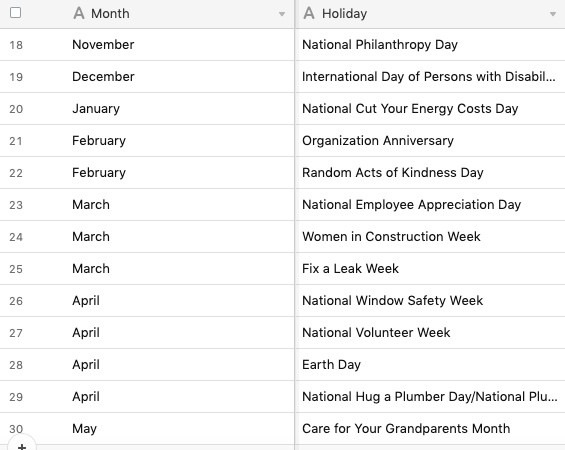by Tareza Chiasson, Scooter Media intern (and expert on quirky holidays!)
Did you know there is a National Spaghetti Day? Fix a Leak Week? National Decorating Month? As PR professionals, part of our job means helping our clients find newsworthy opportunities to expose their organization, brand, and/or products and services to target audiences. While that may not always seem easy, we do have some unique ways to make news out of nothing.
What makes news “news”? Let’s have a refresher on what makes a story newsworthy:
- Timeliness: Is this tied to a day or event?
- Proximity: Is this an issue that’s impacting audiences who reside in the areas these media outlets reach?
- Impact: Does this significantly impact many target audience members?
- Consequence: Are there significant consequences that audiences need to be educated on or aware of?
- Novelty: Is this something quirky, a human-interest story or something with great/weird visuals?
- Prominence: Does this involve a celebrity or high-profile brand?
- Exclusivity: Are we offering the news to a specific outlet before we share the news broadly?
While each of these components can create a “newsworthy” story, having multiple components creates a stronger story. Quirky holidays can have multiple newsworthy components (timeliness, impact, novelty, etc.) and provide a great news hook if leveraged correctly.
The Scooter Media team has put together tips for how brands and organizations can leverage these quirky holidays to their advantage to secure news coverage:
Step 1: Compile a Master List of Holidays
 Creating a list of holidays is an easy way to track and manage days that would be appropriate to celebrate for an organization. When compiling these lists, we recommend including the date(s), description, and client, service, or product it applies to.
Creating a list of holidays is an easy way to track and manage days that would be appropriate to celebrate for an organization. When compiling these lists, we recommend including the date(s), description, and client, service, or product it applies to.
For holidays that change every year, leave a note stating this so your team knows to double-check dates for the holiday during that calendar year.
A description includes what the holiday is, but it can also be a space to describe how others celebrate the holiday, as well as ideas for how your brand or organization can use this day to their advantage. Days that are celebrated rather than only acknowledged are given more attention. For example, recommend promoting discounted or limited-edition margaritas on National Margarita Day, or launching a social media contest where people share stories about the women in their lives for International Women’s Day.
TIP: Creating such an extensive list can be confusing down the line if the list is not labeled or organized properly. We recommend leveraging a platform that can be shared with multiple users and updated in real-time, such as a Google Sheet or AirTable.
Step 2: Ensure the Holiday Aligns with Your Brand
There are few things more awkward than seeing a brand publicly addressing something that isn’t relevant to their business. The same goes for unique holidays. There are enough quirky holidays to go around for every organization, so be sure to find holidays that are right for yours before putting together a pitch. People can recognize when a brand is speaking on something they don’t have a hand in.
Step 3: Draft Your Pitch
The next step is creating a pitch for media outlets. Work with your team to create a pitch that catches the eye of news outlets that are not only relevant to your audiences but also the holiday at hand. State what makes the holiday newsworthy, as well as all necessary information the public needs to know if they are to participate in the celebration with your organization.
For example, it’s very unlikely a business publication would cover a story on International Wacky Shirt Day for a local t-shirt creator. However, it is likely that they may share the story of how that organization came to be during National Small Business Month. Like many other elements of PR, it all comes down to doing proper research about your media outlet and the audiences it serves.
Step 4: Research and Locate Media Contacts
Every media outlet does not find quirky holidays to be relevant to their audience. When pulling media contacts who are relevant to send your pitch to, evaluate your options first. Which outlets do your audiences consume news from? Which news anchors and reporters have covered National Chili Day before? Do any of your media contacts have a personal connection to the holiday?
Sending the pitch to media contacts that are a great fit for your brand or organization but also meet the need of the media outlet or contact raises the likelihood that the pitch will be picked up.
Step 5: Secure Your Coverage
Once you’ve found the appropriate media contacts, it’s time to send your pitch and hope for the story of your dreams!
One example of standout media coverage stemming from a quirky holiday is Scooter Media client Gold Star‘s participation in National Chili Day. Every year for National Chili Day, Gold Star, a regional fast-casual restaurant serving Cincinnati-style chili, celebrates by partnering with the region’s largest foodbank to raise awareness and funds for its programs and services. Scooter Media works to promote the partnership both in advance and on National Chili Day itself to help drive awareness and participation. The partnership has been so successful that the campaign recently expanded from one day to 13 days (in honor of the number of spices in Gold Star’s secret family recipe) to raise even more money for the nonprofit partner.
While it may not always be easy to spread the word about your clients to new audiences, using quirky holidays can be a fun, newsworthy way to do so. If leveraged correctly, these fun holidays can benefit your client’s brand by bringing traction and attention to the products and services they offer. Now go forth and find a few quirky holidays for your brand to celebrate!
Looking for more media relations tips? Check out “Six Tips for Making the Most Out of Your PR Placement,” then discover “4 Tips for Pitching Green Initiatives and Eco-Friendly Brands.”


